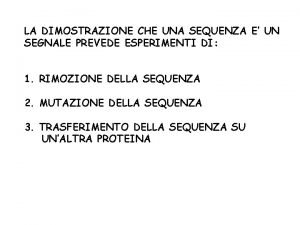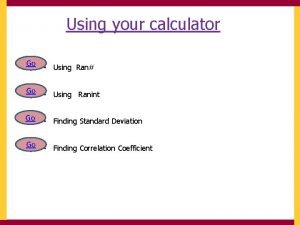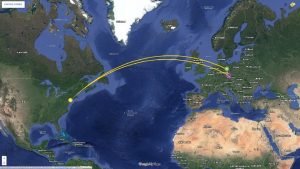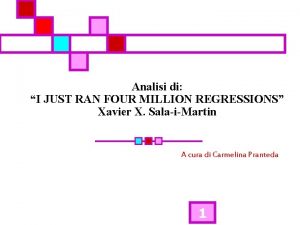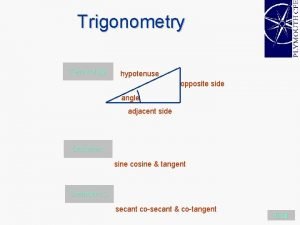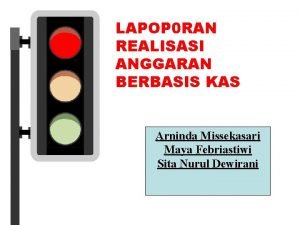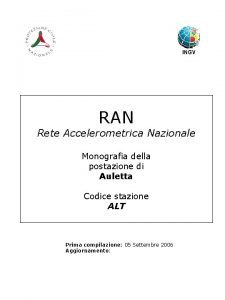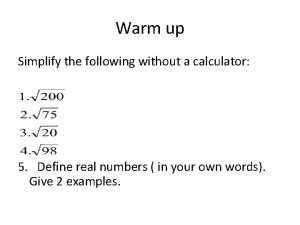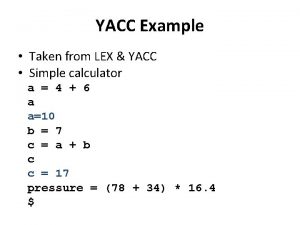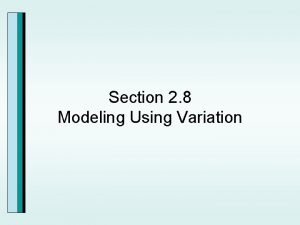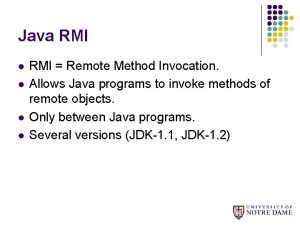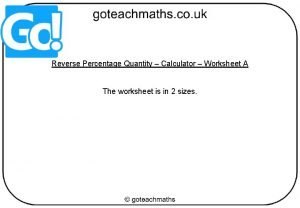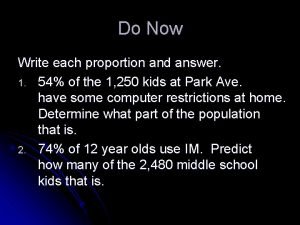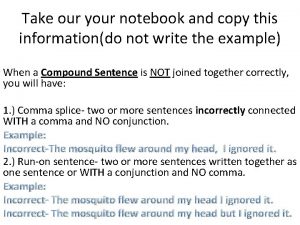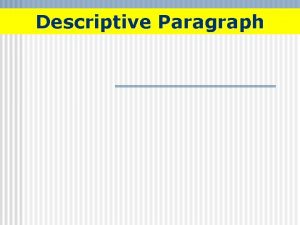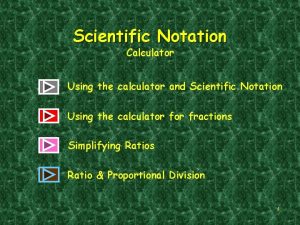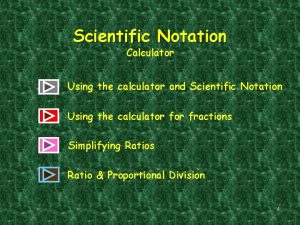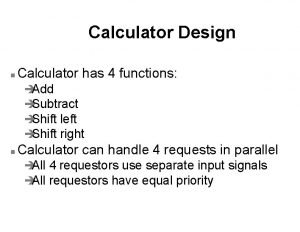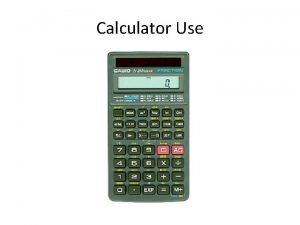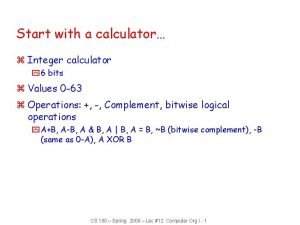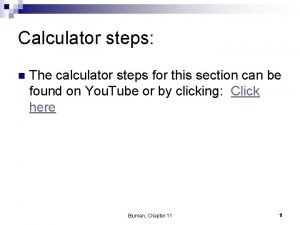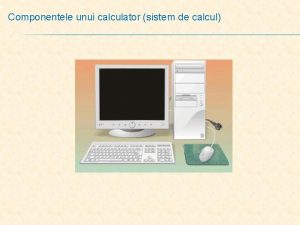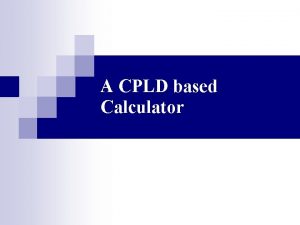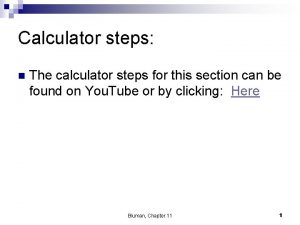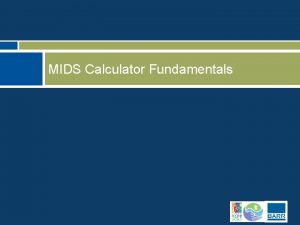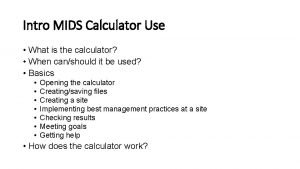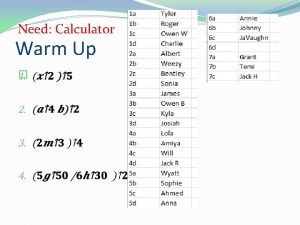Using your calculator Go Using Ran Go Using













![Using Ran# to generate a random whole number within a given interval [1, 200] Using Ran# to generate a random whole number within a given interval [1, 200]](https://slidetodoc.com/presentation_image_h/03b74b5121f9fd454ce33d6d230bc190/image-14.jpg)
















![Generating whole numbers in a given interval [1, 200] using Ranint Generating whole numbers in a given interval [1, 200] using Ranint](https://slidetodoc.com/presentation_image_h/03b74b5121f9fd454ce33d6d230bc190/image-31.jpg)


![Using Ranint We want our interval to be [1, 200] Using Ranint We want our interval to be [1, 200]](https://slidetodoc.com/presentation_image_h/03b74b5121f9fd454ce33d6d230bc190/image-34.jpg)






![Using Ranint To keep generating a random 3 digit number between [1, 200] we Using Ranint To keep generating a random 3 digit number between [1, 200] we](https://slidetodoc.com/presentation_image_h/03b74b5121f9fd454ce33d6d230bc190/image-41.jpg)






















































- Slides: 95

Using your calculator Go • Using Ran# Go • Using Ranint Go • Finding Standard Deviation Go • Finding Correlation Coefficient

Random Sampling using Ran# The Ran#: Generates a pseudo random number to 3 decimal places that is less than 1. i. e. it generates a random number in the range [0, 1] Ran# is in Yellow

Random Sampling using Ran#

Random Sampling using Ran# To keep generating a random 3 digit number between [0, 1] we repeatedly press =

Random Sampling using Ran#

Random Sampling using Ran# The calculator automatically displays in Natural display. If we are generating lots of numbers this may become annoying. We need to Set UP the calculator into Linear Display (as a single line …Decimals)

Random Sampling using Ran#

Random Sampling using Ran# We want it Linear

Random Sampling using Ran# we want a random number again

Random Sampling using Ran#

Random Sampling using Ran# To keep generating a random 3 digit number between [0, 1] we repeatedly press =

Random Sampling using Ran#

Random Sampling using Ran#
![Using Ran to generate a random whole number within a given interval 1 200 Using Ran# to generate a random whole number within a given interval [1, 200]](https://slidetodoc.com/presentation_image_h/03b74b5121f9fd454ce33d6d230bc190/image-14.jpg)
Using Ran# to generate a random whole number within a given interval [1, 200] If we multiply the randomly generated number by 199 then 199 x [0, 1] = [0, 199] To get it between 1 and 200 we must add 1 199 x [0, 1] + 1 = [1, 200] But we must first SET UP the calculator to Fix to 0 decimal place

But we must first SET UP the calculator to Fix to 0 decimal place

But we must first SET UP the calculator to Fix to 0 decimal place

But we must first SET UP the calculator to Fix to 0 decimal place

But we must first SET UP the calculator to Fix to 0 decimal place

The calculator tells us it has been SET UP To Fix We now need to tell it what we want 199 x [0, 1] + 1











Using your calculator Go • Using Ran# Go • Using Ranint Go • Finding Standard Deviation Go • Finding Correlation Coefficient
![Generating whole numbers in a given interval 1 200 using Ranint Generating whole numbers in a given interval [1, 200] using Ranint](https://slidetodoc.com/presentation_image_h/03b74b5121f9fd454ce33d6d230bc190/image-31.jpg)
Generating whole numbers in a given interval [1, 200] using Ranint

Using Ranint is in Red

Using Ranint
![Using Ranint We want our interval to be 1 200 Using Ranint We want our interval to be [1, 200]](https://slidetodoc.com/presentation_image_h/03b74b5121f9fd454ce33d6d230bc190/image-34.jpg)
Using Ranint We want our interval to be [1, 200]

Using Ranint The comma is here in yellow

Using Ranint The comma is here in yellow

Using Ranint

Using Ranint

Using Ranint

Using Ranint The bracket is here
![Using Ranint To keep generating a random 3 digit number between 1 200 we Using Ranint To keep generating a random 3 digit number between [1, 200] we](https://slidetodoc.com/presentation_image_h/03b74b5121f9fd454ce33d6d230bc190/image-41.jpg)
Using Ranint To keep generating a random 3 digit number between [1, 200] we repeatedly press =

Using Ranint

Using Ranint

Using your calculator Go • Using Ran# Go • Using Ranint Go • Finding Standard Deviation Go • Finding Correlation Coefficient

Finding Standard Deviation Find the Standard Deviation of 6, 5, 5, 4, 5, 5, 6, 5 and 4 We first need to make sure the calculator is clear of all previous content

Finding Standard Deviation Find the Standard Deviation of 6, 5, 5, 4, 5, 5, 6, 5 and 4 We first need to make sure the calculator is clear of all previous content

Finding Standard Deviation Find the Standard Deviation of 6, 5, 5, 4, 5, 5, 6, 5 and 4 We want to clear ALL

Finding Standard Deviation Find the Standard Deviation of 6, 5, 5, 4, 5, 5, 6, 5 and 4 Yes reset all

Finding Standard Deviation Find the Standard Deviation of 6, 5, 5, 4, 5, 5, 6, 5 and 4 We really do agree AC

Finding Standard Deviation Find the Standard Deviation of 6, 5, 5, 4, 5, 5, 6, 5 and 4 We want the calculator in stats mode

Finding Standard Deviation Find the Standard Deviation of 6, 5, 5, 4, 5, 5, 6, 5 and 4 We want the calculator in stats mode

Finding Standard Deviation Find the Standard Deviation of 6, 5, 5, 4, 5, 5, 6, 5 and 4 We only have 1 variable

Finding Standard Deviation Find the Standard Deviation of 6, 5, 5, 4, 5, 5, 6, 5 and 4 We now input our data pressing = after each term

Finding Standard Deviation Find the Standard Deviation of 6, 5, 5, 4, 5, 5, 6, 5 and 4

Finding Standard Deviation Find the Standard Deviation of 6, 5, 5, 4, 5, 5, 6, 5 and 4

Finding Standard Deviation Find the Standard Deviation of 6, 5, 5, 4, 5, 5, 6, 5 and 4

Finding Standard Deviation Find the Standard Deviation of 6, 5, 5, 4, 5, 5, 6, 5 and 4 Repeat this process until the data is entered

Finding Standard Deviation Find the Standard Deviation of 6, 5, 5, 4, 5, 5, 6, 5 and 4 We have finished inputting the data. We now need to get to where we can analyse it Press AC

Finding Standard Deviation Find the Standard Deviation of 6, 5, 5, 4, 5, 5, 6, 5 and 4 We need to analyse the stats we have input

Finding Standard Deviation Find the Standard Deviation of 6, 5, 5, 4, 5, 5, 6, 5 and 4 We need to analyse the stats we have input

Finding Standard Deviation Find the Standard Deviation of 6, 5, 5, 4, 5, 5, 6, 5 and 4 We want to see the Variance

Finding Standard Deviation Find the Standard Deviation of 6, 5, 5, 4, 5, 5, 6, 5 and 4 We want the standard Deviation σx

Finding Standard Deviation Find the Standard Deviation of 6, 5, 5, 4, 5, 5, 6, 5 and 4

Finding Standard Deviation Find the Standard Deviation of 6, 5, 5, 4, 5, 5, 6, 5 and 4 This is the standard deviation of the data set To see more analysis details, analyse the data again

Using your calculator Go • Using Ran# Go • Using Ranint Go • Finding Standard Deviation Go • Finding Correlation Coefficient

Finding Correlation Coefficient Find the Correlation Coefficient for the following data Rainfall (x cm) 4. 5 3. 0 5. 2 5. 0 2. 1 No. of tourists (1000’s 5. 0 8. 0 0. 8 4. 2 4. 8 We first need to make sure the calculator is clear of all 0 0 1. 2 3. 2 previous content 7. 4 9. 4 8. 6 2. 6 Finding Correlation Coefficient

Rainfall (x cm) 4. 5 3. 0 5. 2 5. 0 2. 1 0 0 1. 2 3. 2 No. of tourists (1000’s 5. 0 8. 0 0. 8 4. 2 4. 8 7. 4 9. 4 8. 6 2. 6 We first need to make sure the calculator is clear of all previous content Finding Correlation Coefficient

Rainfall (x cm) 4. 5 3. 0 5. 2 5. 0 2. 1 0 0 1. 2 3. 2 No. of tourists (1000’s 5. 0 8. 0 0. 8 4. 2 4. 8 7. 4 9. 4 8. 6 2. 6 We want to clear Finding Correlation Coefficient All

Rainfall (x cm) 4. 5 3. 0 5. 2 5. 0 2. 1 0 0 1. 2 3. 2 No. of tourists (1000’s 5. 0 8. 0 0. 8 4. 2 4. 8 7. 4 9. 4 8. 6 2. 6 Yes Reset all Finding Correlation Coefficient

Rainfall (x cm) 4. 5 3. 0 5. 2 5. 0 2. 1 0 0 1. 2 3. 2 No. of tourists (1000’s 5. 0 8. 0 0. 8 4. 2 4. 8 7. 4 9. 4 8. 6 2. 6 We really do agree AC Finding Correlation Coefficient

Rainfall (x cm) 4. 5 3. 0 5. 2 5. 0 2. 1 0 0 1. 2 3. 2 No. of tourists (1000’s 5. 0 8. 0 0. 8 4. 2 4. 8 7. 4 9. 4 8. 6 2. 6 We want the calculator in stats mode Finding Correlation Coefficient

Rainfall (x cm) 4. 5 3. 0 5. 2 5. 0 2. 1 0 0 1. 2 3. 2 No. of tourists (1000’s 5. 0 8. 0 0. 8 4. 2 4. 8 7. 4 9. 4 8. 6 2. 6 We want the calculator in stats mode Finding Correlation Coefficient

Rainfall (x cm) 4. 5 3. 0 5. 2 5. 0 2. 1 0 0 1. 2 3. 2 No. of tourists (1000’s 5. 0 8. 0 0. 8 4. 2 4. 8 7. 4 9. 4 8. 6 2. 6 We have 2 variables Finding Correlation Coefficient

Rainfall (x cm) 1 4. 5 2 3. 0 3 5. 2 4 5. 0 5 2. 1 6 0 7 0 8 1. 2 9 3. 2 No. of tourists (1000’s 5. 0 8. 0 0. 8 4. 2 4. 8 7. 4 9. 4 8. 6 2. 6 Useful to write the numbers 1, 2, 3, … above each row so as we can check we are correct We now input the first row of the data into the first column of the table pressing = after each term Finding Correlation Coefficient

Rainfall (x cm) 1 4. 5 2 3. 0 3 5. 2 4 5. 0 5 2. 1 6 0 7 0 8 1. 2 9 3. 2 No. of tourists (1000’s 5. 0 8. 0 0. 8 4. 2 4. 8 7. 4 9. 4 8. 6 2. 6 Finding Correlation Coefficient

Rainfall (x cm) 1 4. 5 2 3. 0 3 5. 2 4 5. 0 5 2. 1 6 0 7 0 8 1. 2 9 3. 2 No. of tourists (1000’s 5. 0 8. 0 0. 8 4. 2 4. 8 7. 4 9. 4 8. 6 2. 6 Finding Correlation Coefficient

Rainfall (x cm) 1 4. 5 2 3. 0 3 5. 2 4 5. 0 5 2. 1 6 0 7 0 8 1. 2 9 3. 2 No. of tourists (1000’s 5. 0 8. 0 0. 8 4. 2 4. 8 7. 4 9. 4 8. 6 2. 6 Finding Correlation Coefficient

Rainfall (x cm) 1 4. 5 2 3. 0 3 5. 2 4 5. 0 5 2. 1 6 0 7 0 8 1. 2 9 3. 2 No. of tourists (1000’s 5. 0 8. 0 0. 8 4. 2 4. 8 7. 4 9. 4 8. 6 2. 6 Finding Correlation Coefficient

Rainfall (x cm) 1 4. 5 2 3. 0 3 5. 2 4 5. 0 5 2. 1 6 0 7 0 8 1. 2 9 3. 2 No. of tourists (1000’s 5. 0 8. 0 0. 8 4. 2 4. 8 7. 4 9. 4 8. 6 2. 6 Finding Correlation Coefficient

Rainfall (x cm) 1 4. 5 2 3. 0 3 5. 2 4 5. 0 5 2. 1 6 0 7 0 8 1. 2 9 3. 2 No. of tourists (1000’s 5. 0 8. 0 0. 8 4. 2 4. 8 7. 4 9. 4 8. 6 2. 6 Finding Correlation Coefficient

Rainfall (x cm) 1 4. 5 2 3. 0 3 5. 2 4 5. 0 5 2. 1 6 0 7 0 8 1. 2 9 3. 2 No. of tourists (1000’s 5. 0 8. 0 0. 8 4. 2 4. 8 7. 4 9. 4 8. 6 2. 6 Finding Correlation Coefficient

Rainfall (x cm) 1 4. 5 2 3. 0 3 5. 2 4 5. 0 5 2. 1 6 0 7 0 8 1. 2 9 3. 2 No. of tourists (1000’s 5. 0 8. 0 0. 8 4. 2 4. 8 7. 4 9. 4 8. 6 2. 6 Repeat this process until the first row has been entered Finding Correlation Coefficient

Rainfall (x cm) 1 4. 5 2 3. 0 3 5. 2 4 5. 0 5 2. 1 6 0 7 0 8 1. 2 9 3. 2 No. of tourists (1000’s 5. 0 8. 0 0. 8 4. 2 4. 8 7. 4 9. 4 8. 6 2. 6 Use the cursor keys to enter the data from the second row Finding Correlation Coefficient

Rainfall (x cm) 1 4. 5 2 3. 0 3 5. 2 4 5. 0 5 2. 1 6 0 7 0 8 1. 2 9 3. 2 No. of tourists (1000’s 5. 0 8. 0 0. 8 4. 2 4. 8 7. 4 9. 4 8. 6 2. 6 Press the right cursor Finding Correlation Coefficient

Rainfall (x cm) 1 4. 5 2 3. 0 3 5. 2 4 5. 0 5 2. 1 6 0 7 0 8 1. 2 9 3. 2 No. of tourists (1000’s 5. 0 8. 0 0. 8 4. 2 4. 8 7. 4 9. 4 8. 6 2. 6 Finding Correlation Coefficient

Rainfall (x cm) 1 4. 5 2 3. 0 3 5. 2 4 5. 0 5 2. 1 6 0 7 0 8 1. 2 9 3. 2 No. of tourists (1000’s 5. 0 8. 0 0. 8 4. 2 4. 8 7. 4 9. 4 8. 6 2. 6 Input the data from the second row Finding Correlation Coefficient

Rainfall (x cm) 1 4. 5 2 3. 0 3 5. 2 4 5. 0 5 2. 1 6 0 7 0 8 1. 2 9 3. 2 No. of tourists (1000’s 5. 0 8. 0 0. 8 4. 2 4. 8 7. 4 9. 4 8. 6 2. 6 We have finished inputting the data. We now need to analyse the STATS Press AC Finding Correlation Coefficient

Rainfall (x cm) 1 4. 5 2 3. 0 3 5. 2 4 5. 0 5 2. 1 6 0 7 0 8 1. 2 9 3. 2 No. of tourists (1000’s 5. 0 8. 0 0. 8 4. 2 4. 8 7. 4 9. 4 8. 6 2. 6 We need to analyse the stats we have input Finding Correlation Coefficient

Rainfall (x cm) 1 4. 5 2 3. 0 3 5. 2 4 5. 0 5 2. 1 6 0 7 0 8 1. 2 9 3. 2 No. of tourists (1000’s 5. 0 8. 0 0. 8 4. 2 4. 8 7. 4 9. 4 8. 6 2. 6 We need to analyse the stats we have input Finding Correlation Coefficient

Rainfall (x cm) 1 4. 5 2 3. 0 3 5. 2 4 5. 0 5 2. 1 6 0 7 0 8 1. 2 9 3. 2 No. of tourists (1000’s 5. 0 8. 0 0. 8 4. 2 4. 8 7. 4 9. 4 8. 6 2. 6 We want use Regression Finding Correlation Coefficient

Rainfall (x cm) 1 4. 5 2 3. 0 3 5. 2 4 5. 0 5 2. 1 6 0 7 0 8 1. 2 9 3. 2 No. of tourists (1000’s 5. 0 8. 0 0. 8 4. 2 4. 8 7. 4 9. 4 8. 6 2. 6 We want the Correlation Coefficient r Finding Correlation Coefficient

Rainfall (x cm) 1 4. 5 2 3. 0 3 5. 2 4 5. 0 5 2. 1 6 0 7 0 8 1. 2 9 3. 2 No. of tourists (1000’s 5. 0 8. 0 0. 8 4. 2 4. 8 7. 4 9. 4 8. 6 2. 6 Press = Finding Correlation Coefficient

Rainfall (x cm) 1 4. 5 2 3. 0 3 5. 2 4 5. 0 5 2. 1 6 0 7 0 8 1. 2 9 3. 2 No. of tourists (1000’s 5. 0 8. 0 0. 8 4. 2 4. 8 7. 4 9. 4 8. 6 2. 6 We have the Correlation Coefficient of the data To see more analysis details analyse the STAT Finding Correlation Coefficient

The line of Best Fit The calculator uses y = A + Bx Instead of y = mx + c 1: A → the y intercept 2: B → the Slope

Using your calculator Go • Using Ran# Go • Using Ranint Go • Finding Standard Deviation Go • Finding Correlation Coefficient
 Sequenza nls
Sequenza nls Ran# in calculator
Ran# in calculator How to use ran# on a calculator
How to use ran# on a calculator Mifflin formula
Mifflin formula Give us your hungry your tired your poor
Give us your hungry your tired your poor Norrbottens handbollförbund
Norrbottens handbollförbund Ran ancpi
Ran ancpi Ran nssmf
Ran nssmf Minimal attachment and late closure
Minimal attachment and late closure Proper noun examples sentences
Proper noun examples sentences Ran raz
Ran raz Why is kyle distraught?
Why is kyle distraught? Personification definition figure of speech
Personification definition figure of speech Ran peleg
Ran peleg The horse raced past the barn fell
The horse raced past the barn fell The metaphor
The metaphor O-ran
O-ran Naughty boy poem summary
Naughty boy poem summary The girl ran her hands on a soft satin fabric
The girl ran her hands on a soft satin fabric O-ran wg2
O-ran wg2 Rận gỗ
Rận gỗ Ran chakrabarti
Ran chakrabarti Sky ran
Sky ran P ran
P ran O-ran oam
O-ran oam Oran osc
Oran osc Sitozol
Sitozol Kyle ran into his house
Kyle ran into his house Oliver spatscheck
Oliver spatscheck Ran x nagoya
Ran x nagoya O-ran
O-ran Nothing can separate even if i ran away
Nothing can separate even if i ran away Hindrances to finishing well
Hindrances to finishing well Iki ran
Iki ran Fronthaul and backhaul transport
Fronthaul and backhaul transport We fired our guns and the british kept a comin
We fired our guns and the british kept a comin Ran ram
Ran ram I just ran
I just ran Sports alliteration examples
Sports alliteration examples Opposite adjacent and hypotenuse
Opposite adjacent and hypotenuse Rắn hổ ngựa
Rắn hổ ngựa Basis ran
Basis ran Ran ancpi
Ran ancpi Logo ran
Logo ran Ran sw
Ran sw Simplify radical expressions using conjugates calculator
Simplify radical expressions using conjugates calculator Volume using cross sections calculator
Volume using cross sections calculator Simple calculator using lex and yacc
Simple calculator using lex and yacc Modeling using variation calculator
Modeling using variation calculator Calculator using rmi in java
Calculator using rmi in java Reverse percentage calculator excel
Reverse percentage calculator excel Accept your loneliness you are your only friend
Accept your loneliness you are your only friend Stop blaming your parents for your problems
Stop blaming your parents for your problems How does the heart pump work
How does the heart pump work Pencil poem for child
Pencil poem for child Introduce your friend to your teacher
Introduce your friend to your teacher Wear your heart on your sleeve idiom meaning
Wear your heart on your sleeve idiom meaning Answer this on your notebook
Answer this on your notebook In your notebook,describe the following
In your notebook,describe the following Enagic comp plan
Enagic comp plan Your conscious awareness of your own name and self identity
Your conscious awareness of your own name and self identity Show me your ways o lord teach me your paths
Show me your ways o lord teach me your paths If your vehicle malfunctions turn on your hazard lights
If your vehicle malfunctions turn on your hazard lights What is real-self
What is real-self Topic for school magazine
Topic for school magazine Your treasure is where your heart is
Your treasure is where your heart is Serve the lord in the days of your youth
Serve the lord in the days of your youth I hope you know somebody loves you
I hope you know somebody loves you Your passenger jammed his finger in the door of your m1114
Your passenger jammed his finger in the door of your m1114 First reconcile with your brother
First reconcile with your brother Each proportion write your answer in your notebook
Each proportion write your answer in your notebook In your notebook write an
In your notebook write an What is your treasure
What is your treasure What is your name and how old are you
What is your name and how old are you I throw my warlike shield
I throw my warlike shield Your health your responsibility
Your health your responsibility Eyes of slat
Eyes of slat Does your walk match your talk
Does your walk match your talk Put your right foot in
Put your right foot in Fight for your family nehemiah
Fight for your family nehemiah Maintaining a healthy body composition and body image quiz
Maintaining a healthy body composition and body image quiz Your vote your choice
Your vote your choice Your service your say guidance manual
Your service your say guidance manual Write answer to the questions in your notebook
Write answer to the questions in your notebook If your instructor were to ask if you cleaned up your room
If your instructor were to ask if you cleaned up your room Copy this in your notebook
Copy this in your notebook Mytcc track login
Mytcc track login Is your arm span your height
Is your arm span your height How to write a postcard
How to write a postcard Pms or pregnancy
Pms or pregnancy Serve as your guide in managing your enterprise
Serve as your guide in managing your enterprise The greatest source of ideas for new products is:
The greatest source of ideas for new products is: Ymyg toolkit
Ymyg toolkit Your kingdom come your will be done
Your kingdom come your will be done Drama acrostic poem
Drama acrostic poem Contoh spatial order
Contoh spatial order
